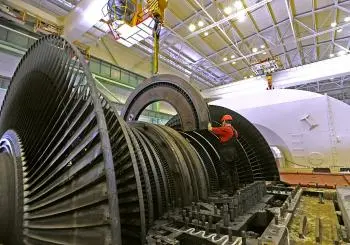
Mechanical engineering plays a critical role in the nuclear power industry, where precision, safety, and efficiency are of paramount importance.
In a nuclear power plant, power is generated by nuclear fission, a process in which atomic nuclei split into smaller nuclei, releasing a significant amount of energy.
To control this reaction and guarantee its safety, several mechanisms are used that unite classical mechanics with nuclear physics:
1. Nuclear reactor: introduction of control rods
The nuclear reactor is the heart of a nuclear power plant. Inside, are the fuel rods, generally enriched uranium, which when bombarded with neutrons, initiate nuclear fission.
To control the reaction rate and avoid overheating, control rods made of materials such as boron or cadmium are used, which absorb neutrons and adjust nuclear activity.
Automation
In many reactors, the process of introducing control rods can be controlled automatically by computerized control systems that constantly monitor nuclear activity and reactor temperature.
Mechanical elements
The mechanical systems that make the movement of the control rods usually include:
-
Hydraulic Actuators and Systems: These actuators can provide fine and precise control.
-
Electric motors: These motors can be electronically controlled to achieve smooth and precise movement.
-
Gear Systems – Gear systems can be used to transmit power from the motor or hydraulic actuator to the control rods.
-
Guides and support structures: These components ensure that the bars move in the desired direction without unwanted deviations.
2. Cooling system
The heat generated in the nuclear reactor must be controlled to prevent damage to components and ensure safe operation. For this, a cooling system is used that circulates a fluid, usually water, through the reactor to absorb the heat.
For this reason, the principles and laws of fluid mechanics play a fundamental role in the design of pumps, valves and pipes in this system.
Mechanical engineering ensures that these components are resistant to radiation and high temperatures.
Below is a description of the main mechanical elements in the refrigeration system:
Circulation pumps
Circulation pumps drive the refrigerant through the refrigeration circuit. These pumps are designed to handle large volumes of coolant and provide the necessary flow to cool the reactor and other components.
Mechanically they must be robust and reliable, since the failure of a pump could have serious consequences.
Heat exchangers
Heat exchangers are designed to transfer heat between the coolant circulating in the reactor and another medium, usually water or steam, which is used to generate power.
These exchangers can be of various types, such as tubes and fins or plates.
Pipes and valves
The refrigeration system uses a network of pipes, valves and pressure switches to transport and regulate the flow of refrigerant.
Pipes must be resistant to radiation and high temperatures, and valves must be capable of precisely controlling flow.
Capacitors (in open circuit systems)
In open-loop nuclear power plants, condensers are used to convert water vapor to liquid, thereby releasing heat.
Condensers are mechanical components that involve the passage of steam through a series of tubes and heat exchange surfaces.
Fans and auxiliary cooling systems
To maintain the proper temperature in the cooling system and the surrounding area, fans and auxiliary cooling systems are used.
These mechanical components help control temperature and maintain proper pressure levels in the system.
Filtration systems
Refrigeration systems can also include mechanical filtration systems to remove impurities and particles from the refrigerant, preventing pipe clogging and premature component wear.
3. Steam generator and turbines
The heat removed from the reactor by the cooling system is used to heat water and produce high pressure steam. This steam is directed towards a mechanical turbine.
Steam turbines convert the kinetic energy of steam into mechanical energy, which is then converted to electricity by an electrical generator.
4. Security system
Safety at nuclear power plants is a priority. Safety mechanisms such as pressure relief valves, fire suppression systems and backup systems are installed to ensure that in the event of an emergency, the plant can be safely shut down and cooled down.


